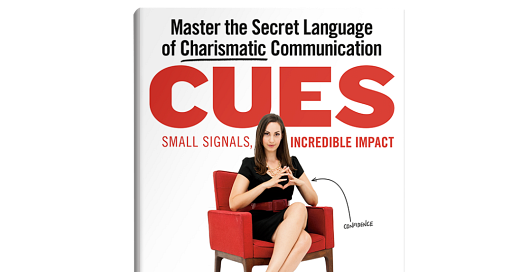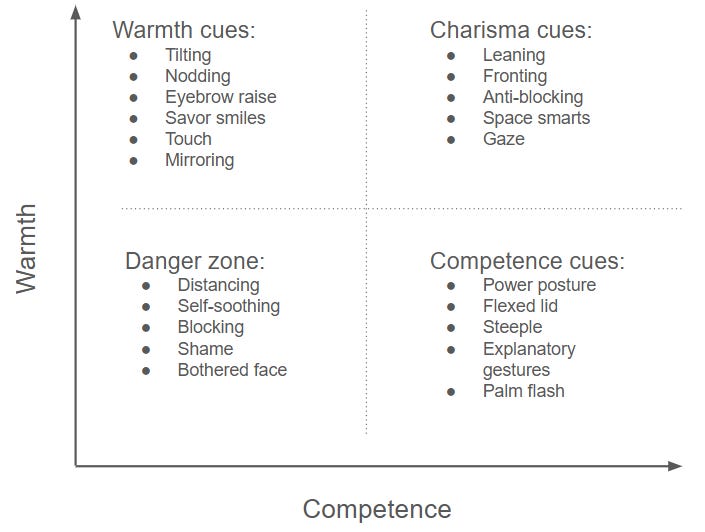The Power of Nonverbal Cues for Charisma (Book Summary, Part Two)
What does body language says about you and others?
Nonverbal cues influence others. If used well, they enhance your perception. If used poorly, people misunderstand you. For instance, strong nonverbal cue recognition can lead to higher salaries. It allows them to accurately read the room and better predict behaviour.
We use nonverbal cues to assess everything: capability, social skills, and even hireability.
The Nonverbal Cues
As a reminder
Charisma = Warmth + Competence
This means your nonverbal cues are not necessarily charismatic. They might lean too much into warmth and competence or, worst-case scenario, neither and make you off-putting.
The diagram below lists nonverbal cues across the spectrum: ideally you want to aim for upper right quadrant. However, it’s worth knowing warmth and competency-leaning cues to adapt to any situation.
Let’s go through the cues in detail.
Charisma Nonverbal Cues
Leaning
Definition: Humans lean toward people, things, and ideas they like.
When to Lean:
To show emphasis.
To show agreement.
To show partnership.
When NOT to Lean:
When you disagree with others.
When you need to create space or boundaries.
If you feel like you’re bowing, you’ve leaned too far.
Fronting
Definition: Fronting is when you angle your body to signal attention. Specifically, you point your three T’s—toes, torso, and top—toward whatever you’re paying attention to.
When to Front:
To signal respect and/or care.
To see what others value.
At the office.
When it’s time to go.
When NOT to Front:
When you want to prevent distraction.
When someone is opening up too much.
When you don’t have time or space.
When you need to be covert.
Anti-blocking
Definition: Making a point of deliberately removing a barrier between yourself and another person.
When to Anti-block:
When you are in one-on-one interactions where you need to build rapport.
When you need to spark ideas.
When you are presenting or pitching.
When you are choosing profile pictures—especially for LinkedIn or dating app profiles.
When NOT to Anti-block:
When openness is not the right message.
When you don’t want to engage.
Space Smarts
Definition: The closer we feel to someone, the closer we allow them to come physically.
How to use Space Smarts:
Respect people’s space boundaries by moving physically closer as you feel more comfortable.
Try a side-by-side.
Use nonverbal bridges to slowly cross into others’ inner space zones.
How NOT to use Space Smarts:
Don’t ever go too close too fast.
Don’t back someone into an actual corner.
Never take a seat choice lightly.
Gaze
Definition: We gaze at people to see what they are thinking, feeling, and paying attention to.
How to Gaze:
Gaze with intent.
Gaze for oxytocin.
How NOT to Gaze:
When you are in a culture where a lot of eye contact is not typical.
When you do not want to stare someone down.
When you do not want to engage with someone.
Warmth Nonverbal Cues
Tilting
Definition: A head tilt shows interest and curiosity because people tilt their heads when trying to hear something more clearly.
When to Tilt:
To show someone you’re interested and listening.
To deliver bad news.
When NOT to Tilt:
If you’re trying to look powerful.
If you want to discourage someone from talking.
If you’re already high in warmth, head tilting will make it hard to climb back into competence.
Nodding
Definition: A vertical head nod means yes, while a horizontal head nod means no.
When to Nod:
To greet someone.
To show agreement.
To encourage someone to keep talking.
When NOT to Nod:
To subtly show disagreement.
If you’re already displaying too many warmth cues.
If you want someone to stop talking.
Eyebrow Raise
Definition: An eyebrow raise signals that you want to see more of something because it is as if you want your eyebrows to get out of the way to see something or someone better.
When to Eyebrow Raise:
When you are seeking confirmation from someone.
When you are actively listening.
When you want to emphasize a point.
When you are wowed by something.
When you want to encourage someone to speak up.
When NOT to Eyebrow Raise:
If someone is pushing your buttons.
If you do not want to look permanently surprised.
When you are in Japan, because it is used to indicate romantic interest.
Savor Smiles
Definition: A real smile is a warmth cue that reaches all the way up into someone’s eyes, while a fake smile does not. Savor smiles are real smiles that take longer to spread across someone’s face.
When to Savor Smile:
When you want to start and end an interaction.
When you want to show someone that you are happy to see them or enjoyed your encounter with them.
When NOT to Savor Smile:
If you’re already too high in warmth.
When you need to show disapproval.
Touch
Definition: Touching can increase oxytocin and encourage trust.
When to Touch:
When you want to trigger warmth, closeness, and trust.
When you want to start, continue, and end an interaction.
When NOT to Touch:
When you don’t feel comfortable with someone or they don’t look comfortable with you.
When you do not want to touch someone belittlingly.
Mirroring
Definition: Mirroring is matching someone's behaviour to show you are on the same page. It is about making someone feel welcome by meeting them where they’re at.
When to Mirror:
When you want to show someone you’re on the same page with them by mirroring any and all positive body language.
When you want to encourage warmth or competence.
When NOT to Mirror:
If you feel awkward or see a cue that doesn’t feel natural to you.
When you do not want to encourage negative cues.
If you aren’t on the same page with someone and want them to know it.
If you do not want to mirror too much or obviously.
Competence Nonverbal Cues
For each cue listed below, return their information from the nonverbal cue chapter of the book. I want the definition and a list of situations when to use and when not to use for each cue.
Power Posture
Definition: Posture is the single most important cue for signalling confidence to others, and when we feel powerful, we take up more space.
When to Use Power Posture:
Whenever you want to both look and feel more competent.
When you check your phone.
When you want to lean on something.
When you want to pick the right chairs for meetings or social events.
When NOT to Use Power Posture:
If you want to show deference, humility, or regret.
If you want to calm someone down or show them you’re not a threat.
If you don’t want to be noticed.
Flexed Lid
Definition: A flexed lid is when you narrow your eyes by hardening your lower lids, and it is a signal of intensity, judgment, and scrutiny.
When to Flex:
When you want to show someone you’re intensely focused on them and using your competence to listen.
If you don’t want to be interrupted.
When you feel suspicious and want someone to expand on their point.
If you want people to think you could be on the cover of People magazine.
When NOT to Flex:
For longer than five seconds.
If someone is really boring and won’t stop talking.
Steeple
Definition: Steepling is when the palms of your hands are facing each other and you gently place just the tips of your fingers together to look like a church steeple.
When to Steeple:
When you want to signal competence, contemplation, and confidence.
To show you’re listening and seriously considering what’s being said and want others to do the same.
To anchor your hands and stop fidgeting.
When NOT to Steeple:
If you feel silly.
If you do not want to hold the steeple gesture all the time.
Explanatory Gestures
Definition: Explanatory gestures are nonverbal cues that help expand, explain, and expound upon verbal messages.
When to Gesture:
When you want to explain something well and have it understood thoroughly.
To show you have confidence in what you’re saying and are competent about your topic.
To be more engaging on video calls or onstage.
When NOT to Gesture:
If you don’t want people to look at you.
If people are staring at your hands while gesturing.
If people are ducking out of the way when you gesture.
Palm Flash
Definition: A palm flash is when you show your palm to cue attention.
When to Palm Flash:
When you want to ask for a handshake.
When you want to ask for a hug.
When you want to ask people to get excited, stand up, or cheer.
When you want to ask people to calm down, sit down, or quiet down.
When you want to ask someone to stop.
When you want to ask someone to tell you more.
When you want to gesture that you’re explaining something.
When you want to gesture that you’re explaining or presenting an idea.
When you want to cue that you would like to say something in a meeting.
When you want to share an idea with someone.
When you want someone to slow down and clarify something they are explaining.
When you want to direct where people should be looking during a presentation.
When NOT to Palm Flash:
If you’re concealing something.
If you do not want to use palm flashes all the time.
Danger Zone Nonverbal Cues
Distancing
Definition: When we do not like something, we physically distance ourselves from it.
When to Distance:
When you have said, seen, or heard something that doesn’t sit right with you.
When NOT to Distance:
When you want to be perceived as charismatic.
Self-soothing
Definition: Self-soothing is when you touch yourself to calm yourself down.
When to Self-soothe:
When you are talking about anxiety-producing topics.
When you want to feel calm and connected.
When NOT to Self-soothe:
When you want to be perceived as charismatic.
When you do not want to distract others.
Blocking
Definition: Blocking our body with our arms, our hands, or a prop like a computer or notebook makes us feel protected but signals close-mindedness.
How to Block:
Block your heart, lungs, and abdomen.
Block your mouth.
Block your eyes.
Shame
Definition: When we feel ashamed, we might touch the sides of our foreheads with our fingertips.
When You Might See Shame:
When you’ve embarrassed someone.
When you’ve stumbled onto a topic that’s too personal or too much.
When someone is confused or worried and doesn’t know how to talk about it.
What to Do If You See Shame:
Research what you did to make someone feel embarrassed, ashamed, or confused.
Welcome shame by offering reassurance and acceptance.
Share a mutual vulnerability.
Bothered Face
Definition: A bothered face is when your face looks irritated, down, or mad even when you feel completely fine.
How to Identify a Bothered Face:
Look for a furrowed brow.
Look for a frown.
Look for a smirk.
Closing Thoughts
And with that we’ve reached the end of the Verbal cues. By now you know how your body language can cue warmth, competence, or preferable charisma. Use these as the situation requires and keep an eye out for how others react too.
Finally, for your convenience, the complete diagram of Verbal cues is repeated below.
Wait for the next post because the next one will round out the summary with the Verbal cues: verbal, vocal, and imagery cues to improve your charisma.





